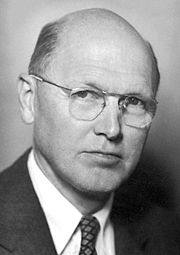Dickinson W. Richards facts for kids
Quick facts for kids
Dickinson W. Richards
|
|
|---|---|

Dickinson W. Richards
|
|
| Born |
Dickinson Woodruff Richards Jr.
October 30, 1895 |
| Died | February 23, 1973 (aged 77) |
| Nationality | American |
| Alma mater | Yale University Columbia University College of Physicians and Surgeons |
| Known for | cardiac catheterization |
| Awards | Nobel Prize in Physiology or Medicine in 1956 |
| Scientific career | |
| Fields | medicine physiology |
| Institutions | Columbia University Bellevue Hospital Presbyterian Hospital |
Dickinson Woodruff Richards Jr. (born October 30, 1895 – died February 23, 1973) was an American physician and physiologist. He is famous for his important work on the heart and lungs. In 1956, he shared the Nobel Prize in Physiology or Medicine with André Cournand and Werner Forssmann. They won the award for developing a special technique called cardiac catheterization. This method helps doctors study the heart and understand many heart problems.
Early Life and Education
Dickinson W. Richards was born in Orange, New Jersey. He went to the Hotchkiss School in Connecticut. In 1913, he started studying at Yale University. At Yale, he focused on English and Greek. He graduated in 1917.
After college, Richards joined the United States Army in 1917. He became an artillery instructor. From 1918 to 1919, he served as an artillery officer in France.
When he returned to the United States, Richards decided to study medicine. He attended Columbia University College of Physicians and Surgeons. He earned his M.A. degree in 1922 and his M.D. degree in 1923.
Medical Career and Discoveries
Richards worked at the Presbyterian Hospital in New York until 1927. Then, he traveled to England to work at the National Institute for Medical Research in London. There, he studied how blood flows in the liver.
In 1928, Richards came back to the Presbyterian Hospital. He began important research on the lungs and the circulatory system (how blood moves through the body). He worked with André Frédéric Cournand at Bellevue Hospital in New York. Their early research looked at ways to study how the lungs work, especially in patients with lung diseases.
Their most important work was developing a technique called cardiac catheterization. This method involves carefully inserting a thin tube (a catheter) into a blood vessel and guiding it into the heart. Using this new technique, they could study many conditions, including:
- Shock, a serious medical condition where the body doesn't get enough blood flow.
- The way the heart works when it's failing.
- How heart medicines affect the body.
- Different types of long-term heart and lung problems.
- How to diagnose congenital heart diseases (heart problems present from birth).
For this groundbreaking work, Richards, Cournand, and Werner Forssmann received the Nobel Prize in Physiology or Medicine in 1956.
In 1945, Richards moved his lab to Bellevue Hospital. In 1947, he became a professor of medicine at Columbia University, where he had been teaching since 1925. He also advised the Merck Sharp and Dohme Company and helped edit the Merck Manual, a well-known medical guide. Richards retired from his positions in 1961.
Awards and Recognition
Dickinson W. Richards received many awards for his contributions to medicine. These include:
- The John Phillips Memorial Award in 1960.
- The Chevalier de la Legion d'Honneur (a French honor) in 1963.
- The Trudeau Medal in 1968.
- The Kober Medal in 1970.
He passed away in Lakeville, Connecticut.
See also
 In Spanish: Dickinson W. Richards para niños
In Spanish: Dickinson W. Richards para niños

